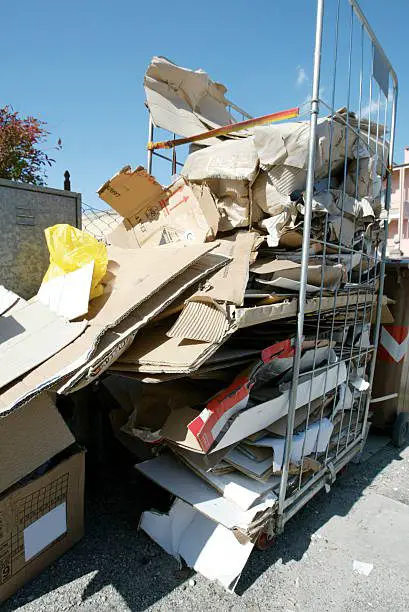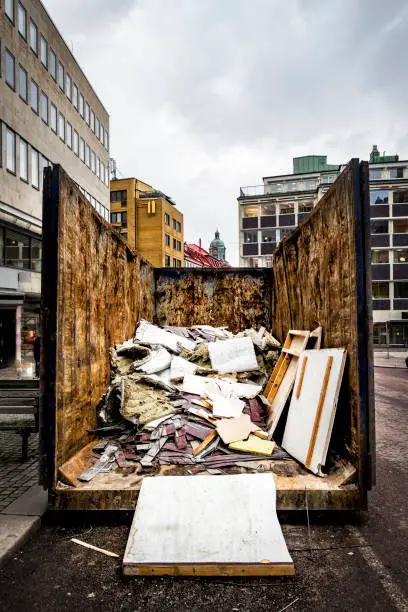Garbage waste products that are produced by corporations, organizations, and institutions are referred to as commercial wastes. Waste from workplaces, stores, factories, building sites, and other business ventures might be included in this. Papers, packaging materials, plastics, and food scraps are typical examples of business wastes.
It’s essential to dispose of business garbage properly to save the environment and the general public’s health. Recycling, composting, and the safe disposal of hazardous waste are ways to do this. Commercial trash recycling is crucial for a number of reasons.
By lowering the need to mine new raw materials, it first aids in the conservation of natural resources. This might support the preservation of biodiversity and ecosystems.
The second benefit of recycling is that it reduces the quantity of garbage that is dumped in landfills, which may assist to lessen pollution and greenhouse gas emissions.
By supplying new goods with raw materials and obviating the need for energy-intensive manufacturing processes, recycling may also drive employment creation and economic expansion. Recycling garbage also saves businesses money since it lowers disposal costs and allows them to make money from the sale of recyclables.
In general, recycling business trash is a crucial step in promoting sustainability and safeguarding the environment. Various risks to both the environment and human health may be posed by commercial waste. Several instances include:
i. Chemical dangers: Some business trash, like batteries, electronics, and pesticides, may contain harmful compounds that might endanger both human health and the environment by leaching into the land and water.
ii. Biological risks: If handled and disposed of improperly, medical waste including sharps and infectious materials may spread illnesses and infections.
iii. Physical dangers: If not disposed of appropriately, large or heavy things like furniture or appliances may be harmful and lead to injury or equipment damage.
iv. Fire risks: If not kept or disposed of appropriately, certain business trash, such as aerosol cans, can ignite and provide a fire danger.
These risks may be reduced with effective waste management, which includes segregation, storage, transportation, and disposal. Depending on the jurisdiction, different restrictions apply to the storage, treatment, transportation, and disposal of commercial trash, which is often created by enterprises.
This may include specifications for the waste materials correct labeling and packing as well as rules for the kinds of trash that can be disposed of in certain ways (such as hazardous waste that must be specially handled).
The Environmental Protection Agency (EPA) in the US establishes national standards for the treatment of commercial garbage, although individual states and municipalities may also have their own rules.
For instance, California has a thorough set of standards for managing business trash, including guidelines for recycling and composting. To prevent fines or penalties, it is crucial for companies to be aware of and adhere to all relevant legislation.
They might also think about putting their own sustainability initiatives into action, such as cutting down on waste, recycling, or using eco-friendly goods and services.
The Products Derived From Commercial Wastes

Depending on the kind of waste and the manner of processing, a variety of products may be made from commercial wastes. Several instances include:
(1) Recycled paper
Paper goods generated from post-consumer waste, such as used office paper, newspapers, and cardboard boxes, are referred to as recycled paper from commercial wastes. To make new paper goods, this kind of paper is gathered, processed, and then utilized.
Recycling paper decreases the need for virgin fibers, aids in resource conservation, lowers energy consumption and pollution during production, and also lowers the quantity of garbage dumped in landfills. Office paper, newspapers, and cardboard may all be made from recycled commercial paper waste.
The following items may be created with recycled paper:
• Newsprint and other forms of printing paper
• Insulation Materials
• Biodegradable plant pots
• Paper-based packaging materials including cereal boxes and food cartons
• Animal bedding
• Paper bags and envelopes
• Tissue paper and paper towels
• Mulch and compost
Read Also: The products derived from coffee Wastewater
(2) Items made of plastics
When anything is constructed of plastic utilizing materials that have been gathered from commercial sources, such as packaging or abandoned plastic goods, it is referred to as being made of commercial trash.
These resources may be recycled and utilized to make new items, lessening the need for virgin plastic and contributing to the reduction of plastic waste in the environment.
Recycling plastic trash allows for the creation of brand-new consumer items, packaging, and container types. Recycled plastic may be used to create a wide range of items, including:
i. Recycled plastic bags and packaging materials
ii. Plastic lumber for decking, fencing, and outdoor furnishings
iii. Plastic bottles and containers are recycled and used to make industrial products, carpets, and apparel.
iv. Plastic pallets for storage and transportation
v. Drainage systems and plastic pipes
vi. playground equipment, picnic tables, and park seats
vii. Plastic wraps and sacks for use in agriculture
viii. Recycled plastic pellets used in the production of new plastic goods
Plastic may be recycled and used for road building as well as fuel for automobiles and industrial units.
(3) Power
Trash-to-energy is a method for turning commercial waste into energy (WTE). In this procedure, waste materials are burned in a regulated setting, like a waste-to-energy power plant, to create steam that may be utilized to create electricity.
Anaerobic digestion, a procedure that employs microorganisms to break down organic materials and create methane-rich biogas that may be used as fuel, can transform other types of business waste, such as food waste, into energy.
Additionally, pyrolysis, which involves burning the material in the absence of oxygen to break it down into valuable compounds, may be used to turn certain types of business waste, like plastic, into fuel.
Commercial trash may also be converted into energy, such as in the waste-to-energy (WTE) process, which turns the heat from burning garbage into electricity.
Read Also: The Products Derived From Clinical Wastes
(4) Used metals
Collecting and processing scrap metal from companies and industries, such as building sites, industrial facilities, and demolition projects, is necessary to recycle metal from commercial trash. After being cleaned and sorted, the scrap metal is melted down to be employed in the creation of new goods.
This procedure helps to keep expenses down while conserving natural resources, cutting down on energy use and emissions. To create new metal goods like cans, vehicles, and appliances, scrap metal can be gathered and recycled. Products like the following may be created from recycled metals:
I. Recycled steel: used in building, cars, and appliances.
II. Recycled aluminum: used in cans, foil, and construction materials.
III. Recycled brass: used in plumbing fixtures and musical instruments.
IV. Recycled lead: used in batteries and radiation protection.
V. Recycled gold and silver: used in jewelry and electronic parts.
(5) Recycling
The act of employing microorganisms to break down organic items like food scraps, yard trash, and paper products into a nutrient-rich soil supplement known as compost is known as composting commercial wastes.
This procedure may be carried out on a smaller scale in a corporate or community environment, as well as in a commercial setting like a landfill or waste management facility. Composting may help cut down on trash that is dumped in landfills and can be used to produce fertilizer for farms and gardens.
Prior to beginning composting, it is crucial to make sure that any potentially dangerous elements are eliminated from the waste stream, such as meats and dairy products that may attract unwelcome bugs. Composting organic waste may result in a nutrient-rich soil amendment for agriculture and gardening.
Compost and other nutrient-rich soil supplements are made from commercial waste that may be used in landscaping, farming, and gardening to increase the health and fertility of the soil. Additionally, compost may be used as a mulch to control soil temperature, keep soil wet, and prevent weed growth.
Vermicompost (vermi-compost), or compost created with worms, and compost tea are other goods (a liquid extract of compost used as a fertilizer or soil amendment). Compost may also be used in bioremediation, a procedure that involves employing living things to clean up contaminated areas.
Read Also: Importance of farm supply

